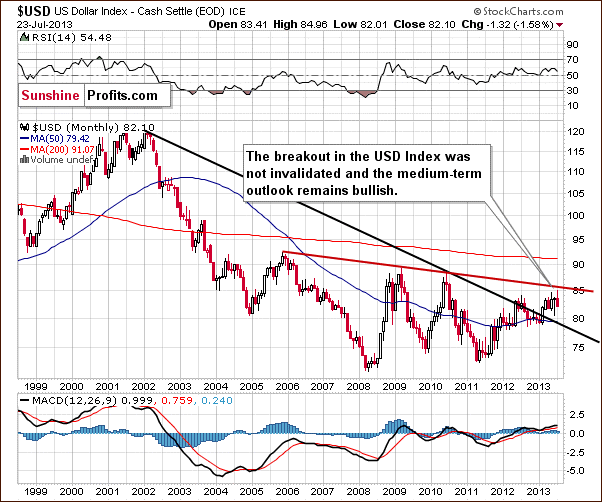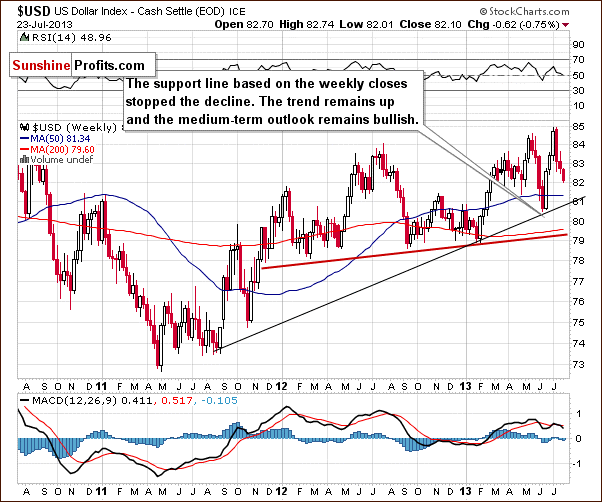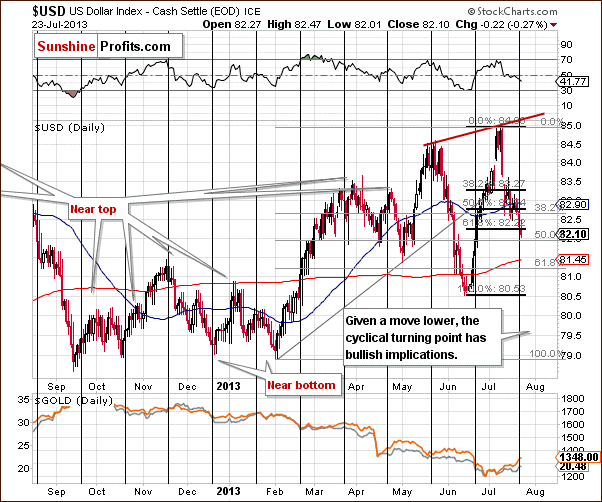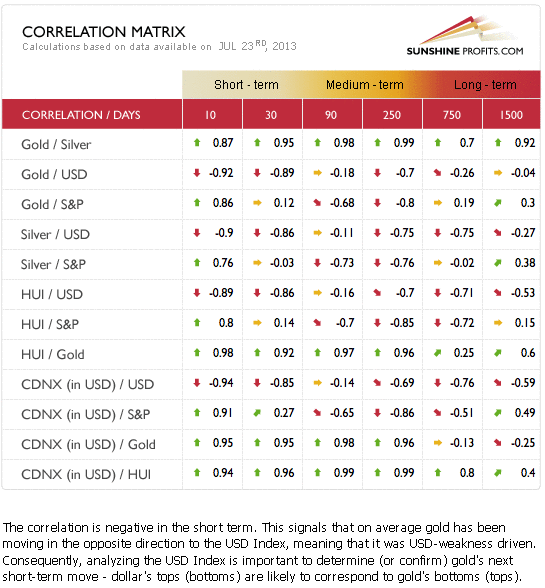Timing & trends
Yesterday, gold climbed up to over $1,347 per ounce after the U.S. dollar slipped against other currencies. The American currency dropped to a one-month low slightly below 82 after extending a broad decline for a third session. Investors are probably wondering if it will drop any further.
The recent price action suggests that market players are still long the dollar, which could weigh on the greenback, said Hiroshi Maeba, head of FX trading Japan for UBS in Tokyo.
What if he is right? Will the buyers manage to push the USD Index higher? What impact could such action have on the gold’s chart? Could it trigger a correction?
Today, gold slipped as investors took profits after a sharp four-day rally which pushed prices up to a one-month top in the previous session. Can the yellow metal climb higher in the near term? Is the final top already in? Can we find any guidance in the charts?
In today’s essay we examine the US Dollar Index once again and the gold chart from the perspective of the Australian dollar to see if there’s anything on the horizon that could drive gold prices higher or lower shortly. We’ll start with the USD Index very long-term chart to put this gold chart into perspective (charts courtesy by http://stockcharts.com.)

As we wrote in our essay on gold, stocks and the dollar on July 22,2013:
The situation in the long-term chart hasn’t changed recently. The breakout above the declining support/resistance line (currently close to 79) was still not invalidated.
From this perspective the situation remains bullish.
Now, let’s zoom in on our picture of the USD Index and see the medium-term chart.

When we take a look at the above chart we can see that the USD Index has declined once again. Despite this fact, the recent declines haven’t taken the index below 81, so the medium-term uptrend is not threatened. The reason for this is that the medium-term support line hasn‘t been broken, in fact, it hasn’t even been reached.
From this perspective, the situation remains bullish, and we can expect the dollar to strengthen further in the coming weeks.
Now, let’s check to see if the short-time outlook is also bullish.

It is. From the short-term perspective, we see that earlier this week, the U. S. dollar dropped slightly below the 61.8% Fibonacci retracement level based on the June – July rally. It also declined to slightly above 82 on an intra-day basis on Tuesday. The move below this level is not confirmed, however.
Moreover, when we factor in the Fibonacci price retracement based on the entire February – July rally, we see that the USD Index moved to the 50% Fibonacci retracement level which is at the 82 level. In fact, the existence of this level might explain why dollar moved slightly below the short-term 61.8% retracement.
All in all, from the price perspective, it still seems that a rally will follow.
The most important factor on the above chart supporting the bullish case is the cyclical turning point which is in play right now. It’s quite possible that we will see its impact on the dollar this week, and this can lead to a bigger pullback. This provides us with strong bullish implications from this perspective.
Combining both perspectives – a move to the upside is still likely to be seen. If the buyers manage to push the USD Index higher, we might see an increase to the level of the June top or even to the rising resistance line based on the May high and June peak before another pause is seen. Taking a look at the long-term charts, however, we see that the next significant resistance is currently close to 86 (86.4) – the declining red line in the chart.
Consequently, from the short-term perspective, we see that the recent decline still seems to be a counter-trend bounce. When we factor in the cyclical turning point we could see another rally soon. Taking a look at medium- and long-term charts, both outlooks for the dollar remain bullish. This is a bearish piece of information for metals and miners.
To make the U.S. dollar perspective complete, let’s analyze the impact of the American currency upon the precious metals sector. Let’s take a look at the Correlation Matrix (namely: gold correlations and silver correlations).

We have seen negative correlation between the metals and the USD Index. Taking the short-term, bullish outlook for the USD Index into account, the implications for gold, silver, and the mining stocks are clearly bearish at this time.
Once we know the current situation in the U.S currency and its impact upon the metals, let’s turn to our final chart. Today, we would like to present you an interesting chart which may provides important clues about further gold’s price movements: the chart of gold from the perspective of the Australian dollar.
Click HERE or on chart for larger image
On the above chart, we see that the price of gold in Australian dollars has moved up and almost reached the declining resistance line. At this point, it’s worth mentioning the previous local top. We saw a pullback to this resistance line in June, but the buyers didn’t manage to push gold above it. This resulted in strong declines which took the price all the way down to the April bottom area. If we see similar price action here, gold priced in Australian dollars will likely decline once again. Such a triple-bottom, in this case, would likely mean a breakdown below the previous lows in the price of gold seen from our regular USD perspective, similar to what was seen in June.
Summing up, the situation in the USD Index is particularly interesting this week. Prices are close to the final Fibonacci retracement level and right at the cyclical turning point (and following a sharp decline). A rally seems quite likely in the cards for the short term, and this will probably have a very negative impact on the precious metals.
Thank you for reading. Have a great and profitable week!
Przemyslaw Radomski, CFA
Founder, Editor-in-chief
Gold Investment & Silver Investment Website – SunshineProfits.com
* * * * *
Disclaimer
All essays, research and information found above represent analyses and opinions of Przemyslaw Radomski, CFA and Sunshine Profits’ associates only. As such, it may prove wrong and be a subject to change without notice. Opinions and analyses were based on data available to authors of respective essays at the time of writing. Although the information provided above is based on careful research and sources that are believed to be accurate, Przemyslaw Radomski, CFA and his associates do not guarantee the accuracy or thoroughness of the data or information reported. The opinions published above are neither an offer nor a recommendation to purchase or sell any securities. Mr. Radomski is not a Registered Securities Advisor. By reading Przemyslaw Radomski’s, CFA reports you fully agree that he will not be held responsible or liable for any decisions you make regarding any information provided in these reports. Investing, trading and speculation in any financial markets may involve high risk of loss. Przemyslaw Radomski, CFA, Sunshine Profits’ employees and affiliates as well as members of their families may have a short or long position in any securities, including those mentioned in any of the reports or essays, and may make additional purchases and/or sales of those securities without notice.

 World famous gold guru Jim Sinclair is telling his followers that the gold price will soon move in ‘hundreds of dollars a day’ when the Comex changes its settlement rules as it must because the exchange is running out of physical gold.
World famous gold guru Jim Sinclair is telling his followers that the gold price will soon move in ‘hundreds of dollars a day’ when the Comex changes its settlement rules as it must because the exchange is running out of physical gold.
‘The cause of today’s spectacular rise in the gold price is the reality that with Friday continue large drop in Comex warehouse gold inventory,’ he writes. ‘No cogent argument can be formed against the reality that because of the continue fall in gold inventory that within in 90 days or sooner the Comex must change its delivery mechanism.
Cash settlement
‘The highest probability is that Comex will have to move to cash settlement rather than gold. Part of that settlement could be lots of 100,000 GLD (gold exchange traded fund) that represents the ability to exchange for gold.
‘Their problem is that if GLD is part of the settlement mechanism for the spot Comex contract that GLD will be destroyed by the convertibility. It is a truism in gold that which is convertible into gold will in fact be converted over time.
‘Gold rose today because those knowledgeable know the inevitability of the changing of the Comex contract, as it is today which calls for settlement in gold between contracting parties. There is no question this is the emancipation of physical gold from the fraud of no gold, paper gold.
‘The emancipation will cause physical gold exchanges to take birth and to be the discovery mechanism for the price of gold. This is the end of the ability to use paper gold future contracts as a mechanism to make the gold price sing and dance at the will of the manipulators.
True value
‘With manipulation coming to an end the true value of gold will be discovered by the cash exchanges that are now taking birth. The advent of the cash spot exchanges around the world is the natural demise of the Comex set up as convertible and now being converted.
‘As long as one can buy spot, pay insurance, transportation and re-casted by Rand Refinery to Asian products sold profitably, the demands for real gold are ending the hay days or even existence of the futures exchanges.
‘Gold is headed back to be traded as it was before 1973. Gold will trade well above $3,500 and those who have lived in the gold market like me for now 53 years know it. A price of $50,000 for gold is not out of the question as a result of its emancipation from fraudulent paper, no gold, paper gold.’
Gold running out
He continues: ‘The warehouse inventory of every futures gold exchanger is screaming this. The fact that there is no meaningful above ground supply of gold is screaming this. The fact that most of the central banks supply of gold is leased is screaming this.
‘There is no reason why gold cannot move up hundreds of dollars a day when the Comex changes their spot contract settlement, as they must, as they will, very soon.’
The next edition of the popular ArabianMoney investment newsletter has an exclusive interview with Jim Sinclair and edited highlights of his four-hour presentation in Vancouver on July 10th. Sign up to see this private circulation publication (click here).

 I’ve spun a few yarns in recent years about my days as a naval officer; not, thank goodness, tales told by dead men, but certainly echoes from the depths of Davy Jones’ Locker. A few years ago I wrote about the time that our ship (on my watch) was almost cut in half by an auto-piloted tanker at midnight, but never have I divulged the day that the USS Diachenko came within one degree of heeling over during a typhoon in the South China Sea. “Engage emergency ballast,” the Captain roared at yours truly – the one and only chief engineer. Little did he know that Ensign Gross had slept through his classes at Philadelphia’s damage control school and had no idea what he was talking about. I could hardly find the oil dipstick on my car back in San Diego, let alone conceive of emergency ballast procedures in 50 foot seas. And so…the ship rolled to starboard, the ship rolled to port, the ship heeled at the extreme to 36 degrees (within 1 degree, as I later read in the ship’s manual, of the ultimate tipping point). One hundred sailors at risk, because of one twenty-three-year-old mechanically challenged officer, and a Captain who should have known better than to trust him.
I’ve spun a few yarns in recent years about my days as a naval officer; not, thank goodness, tales told by dead men, but certainly echoes from the depths of Davy Jones’ Locker. A few years ago I wrote about the time that our ship (on my watch) was almost cut in half by an auto-piloted tanker at midnight, but never have I divulged the day that the USS Diachenko came within one degree of heeling over during a typhoon in the South China Sea. “Engage emergency ballast,” the Captain roared at yours truly – the one and only chief engineer. Little did he know that Ensign Gross had slept through his classes at Philadelphia’s damage control school and had no idea what he was talking about. I could hardly find the oil dipstick on my car back in San Diego, let alone conceive of emergency ballast procedures in 50 foot seas. And so…the ship rolled to starboard, the ship rolled to port, the ship heeled at the extreme to 36 degrees (within 1 degree, as I later read in the ship’s manual, of the ultimate tipping point). One hundred sailors at risk, because of one twenty-three-year-old mechanically challenged officer, and a Captain who should have known better than to trust him.We survived, and a year later I exited – the Diachenko and the Navy for good – theirs and mine. I think I heard a sigh of relief as I saluted the Captain for the last time, but in memory of those nearly tragic moments, let me reprint an article posted on wikiHow, outlining exactly how to go about abandoning ship should you ever venture into the South China Sea or anywhere close to Davy’s infamous locker. The article is a bona fide and serious attempt to instruct would be passengers in a Titanic-like disaster. I found it, however, as comical as yours truly pretending to be a chief engineer in 1969. Judge for yourself…
…….read more HERE

 If you think gasoline is expensive now, imagine the price when Iran and Israel start lobbing nukes at each other.
If you think gasoline is expensive now, imagine the price when Iran and Israel start lobbing nukes at each other.
Am I having a nightmare? No, I’m fully awake. That snoozing you hear is an energy market blissfully unaware of potential major war in the Middle East. The shooting could begin as soon as this year.
The world’s financial markets are completely discounting the very real possibility of an Israeli-Iranian war. Years of anger, threats and caustic rhetoric have put the so-called “experts” to sleep. Their blindness is incredibly dangerous for everyone.
Just look what’s happening RIGHT NOW. Israeli jets are already flying into Syria and Lebanon, disabling air-defense systems. Why?
To me, it’s obvious. Israel is clearing the path for a first strike against Iran’s nuclear missile launchers.
Israel’s Benjamin Netanyahu is not kidding. He will not allow Iran to have nuclear weapons. If he can’t stop them through negotiations, he will do whatever it takes.
Most people discount the possibility of an Israeli “first strike” for logistical reasons. They believe Israel would need U.S. cooperation to strike deep inside Iran. We could certainly make it easier for them. The U.S. could provide aerial refueling and other support while Israel drops the bombs.
With his nation’s very survival at stake, Netanyahu is also preparing to go it alone.
Some think Iran’s newly elected Hassan Rouhani, who takes over as president next month, will extend an olive branch. This is pure fantasy!
Rouhani is a wolf in sheep’s clothing. He was hand-picked by Iran’s Supreme Leader Ali Hosseini Khamenei to for two purposes …
First, Rouhani needs to satisfy Iran’s increasingly restless public. The massive protests of the last few years represent a real threat to Iran’s theocratic regime. The daily struggles created by economic sanctions are real. Rouhani must convince them he is working to end the country’s economic isolation.
Second, Rouhani will buy time with the Western powers by pretending to be a moderate, reasonable leader. Meanwhile the nuclear and missile programs will move forward. The Iranian regime believes that once it has nuclear warheads and missiles to deliver them, it can force an end to the devastating economic sanctions.
I believe both the U.S. and Iran underestimate Netanyahu’s willingness to go to war. One way or another, he will stop Iran from obtaining nuclear weapons.
Netanyahu’s “Face the Nation” appearance last week was a clear warning to the United States and other world powers. Incredibly, almost no one noticed. (See my publisher Brad Hoppman’s excellent July 17 analysis of the media missing the mark.)
The Obama administration is not blind. They know war between Iran and Israel is all but certain. They are doing all they can to postpone the inevitable.
The U.S. has its own reasons to stop Iran. So do other regional powers like Saudi Arabia. They simply want Israel to do the dirty work.
The good news: Iran will not have a chance to nuke Israel.
The bad news: The war to stop it will be ugly.
Here is how I think events will unfold …
- An Israeli strike on Iran nuclear facilities and missile development infrastructure will lead to …
- Vicious air war over Syrian, Lebanese and Iraqi airspace, followed by …
- An Israeli land invasion of Lebanon to neutralize Hezbollah’s rocket capacity, while …
- Iran tries to choke off oil exports through the Strait of Hormuz!
Then it will get even worse …
- Egypt’s paramilitary Muslim Brotherhood will obstruct the flow of oil through the Suez Canal.
- The final blow: an Iranian missile strike on Saudi oil fields.
When all this happens — and it will — world markets will suffer the worst one-day loss since 9/11. Crude oil could skyrocket to as high as $200. I expect to see gold make daily jumps of $100 or more.
If U.S. carrier groups in the Arabian Sea come under fire, we could see $300 oil and $2,000 gold — or even more!
I refuse to be guilty of willful blindness. That’s why I’m telling my subscribers how to prepare.
In Global Resource Hunter, I am planning hedges against the stock market’s visceral reaction to the coming Israeli strike. And my Junior Resource Millionaire subscribers will get recommendations designed to rack up substantial profits in the coming crisis. In both services, I am aiming to help members to maximize their profit potential in the wild swings we will see for both commodities and equities.
Whatever you do, keep your eyes open your eyes and prepare for the inevitable. You can survive — and even profit — from the trouble ahead. Don’t wait too long.
Best wishes,
James

 Federal Reserve Chairman Ben Bernanke Thursday said falling gold prices may reflect less concern among investors about “extreme outcomes” for the economy.
Federal Reserve Chairman Ben Bernanke Thursday said falling gold prices may reflect less concern among investors about “extreme outcomes” for the economy.
“Gold is an unusual asset. It’s an asset that people hold as a sort of disaster insurance,” Mr. Bernanke said in response to a question at a Senate Banking Committee hearing.
Gold prices have dropped near three-year lows in recent weeks as the economy shows signs of improving and the Fed has clarified its plans to eventually roll back its bond-buying program.
Mr. Bernanke said those lower prices may reflect greater confidence about the economy and less concern that Fed programs will cause inflation to spike.
Still, the Fed chairman said gold isn’t such a great hedge against inflation. “Movements of gold prices don’t predict inflation very well,” he said.
Mr. Bernanke also offered a major caveat to his assertions about gold: “Nobody really understands gold prices and I don’t pretend to understand them either,” he said.
Bernanke Explains How Fed Views Inflation
There’s long been a gulf between how people view inflation and how central bankers take account of price pressures.
For most people, food and energy costs are among the most important, and most volatile, prices they confront on a daily basis. If those prices rise, that means inflation is on the march, regardless of the readings on the wide range of price data ginned up by government agencies monthly.
…..read it all HERE













